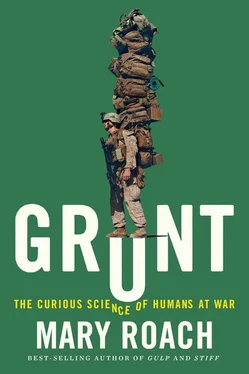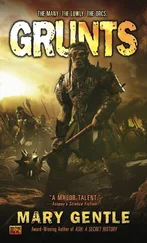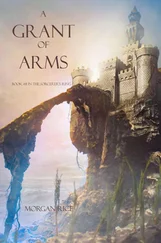I emailed White the night after we met. It began as a thank-you, but came around to a sort of grasping fan letter. My world is full of people, and that includes me, who never have to put their lives and bodies on the line for other human beings or for things they believe in. Hero has always been a movie word, a swelling orchestral soundtrack word. A Walter Reed hallway word. Now it has something under it.
SURGERY PATIENTS are announced like guests at a ball. An orderly wheels them in and recites from the paperwork: name, age, procedure, body part. To be sure the surgeons are in the right room, with the right patient and the right piece. In White’s case, you might otherwise wonder. A nurse is swabbing the surgical site, applying the standard antiseptic man-tan, but she’s at his face, not his groin. Major Molly Williams, the almost comically pregnant assisting-surgeon, explains that a replacement stretch of urethra will be built from a strip of tissue harvested from the inside of White’s cheek. Mouth tissue makes an excellent urethral stand-in. For one thing, it’s hairless. Urine contains minerals that, were there hair growing in your urethra, would build up on the strands. The stony deposits are troublemakers, obstructing flow or breaking free and getting peed out in a blaze of pain.
The surgeon, James Jezior, has been over at the scrub sink going at his nails. He joins us now, hands front, drying. He has blue eyes and fine sandy hair and a mischievous wit. I would use the adjective boyish , but on paper he is very much not a boy. He’s a chief (of the Walter Reed urology department), a director (of reconstructive urology), and a colonel.
“Also,” says Jezior, “the mouth is tolerant of pee.” He means that the mouth is built for moisture. It’s possible to create a urethra from hairless skin on the underside of the forearm or behind the ear, but the frequent wetting from urine can degrade it. A kind of internal diaper rash may ensue. Inflammation eats away at the tissue, tunneling an alternate path for the waste, called a fistula. Now you are dribbling tinkle from a raw hole in your skin. Just what you need.
White’s face has been draped with a blue sterile cloth with a single opening, reminiscent of an Afghan burqa. In this case, the opening is positioned over the mouth, not the eyes, as though the patient belonged to some esoteric spin-off sect. Retractors square White’s mouth, pulling it wide to either side, the way kids will do with their fingers to frame a stuck-out tongue. Jezior outlines the graft with a surgical marker and uses an electrocauterizing tool to cut it free. A vaguely familiar aroma, somewhere between brazier and burning hair, hits the air. Jezior is indifferent to it but reveals that the prostate, when cut open, releases a distinctive scent that’s kind of nice.
Using long-handled forceps, Jezior passes the dangling tissue to Molly. They look like a couple sharing a Chinese entrée. Molly drapes the graft over one gloved thumb and, with her other hand, snips away bits of fat and tissue to make it thinner. It takes time for new blood vessels to grow in and service a graft. For the first couple of days, the cells of the graft are nourished by a broth of serum. If the graft is too thick, only the cells on the surface will thrive, and those on the interior will die. For this reason, larger skin grafts, like the ones on the back of White’s remaining leg, are run through a mesher. The holes of the mesh create more surface area for the business interactions of cellular life: nutrients in, waste out.
If replacing part of the urethra doesn’t resolve the problem, another option would be perineal urethrostomy. Here the surgeon would excise the damaged portion and thread the shortened urethra through an opening in the perineum—the no-man’s-land between scrotum and rectum. “Then they have to sit to urinate, like ladies do,” says Molly.
How big of a deal is that? Jezior makes the point that someone whose reproductive organs have been damaged by an IED has typically also lost one or more limbs. Having to sit down to urinate probably doesn’t rank high on the worry list.
Molly tilts her head to face me. “It’s huge.” Depending, to some extent, on culture. Some years back, she attended a session on perineal urethrostomy at an international urology conference. The Italian surgeons were aghast. “You can’t tell an Italian man he’s going to have to pee sitting down.”
Molly was one of two female urologists at the meeting. She notices the disparity, but it doesn’t faze her. On the upside, she never waits for a toilet during session breaks. “I’ve been the only one in the women’s room at some of these urology conventions.”
“Same here,” deadpans Jezior.
The piece of cheek is ready to begin its new career. A nurse pulls a sterile drape from White’s hips and begins rubbing his skin with the antiseptic wand. Such is the vigor of the youthful male that even under general anesthesia, even when it’s a ChloraPrep sponge bestowing the caress, the penis responds. It is a less robust response than normal, perhaps, because Jezior has prescribed something to temporarily blunt erections. Surgical incisions are sewn up while the organ is flaccid; erections stretch the incision. They hurt . However, erections bring more blood into the penis, which speeds healing, and they also help prevent scarring. The latter is important because scarring—especially in erectile tissue—can make erections crooked and uncomfortable. For this reason, sexual activity is sometimes encouraged postoperatively as a kind of physical therapy for the penis. Walter Reed nurse manager Christine DesLauriers, whom we’ll shortly meet, convinced the intensive care unit staff to establish a daily “intimate hour,” during which no medical staff would visit the patient’s room, just spouses and partners.
Jezior opens the organ to access the urethra. As he works, he rests the heel of one hand on White’s scrotum, using it like a tiny beanbag chair. Molly’s style is more formal; she holds her instruments like a knife and fork, wrists raised. The rectangular graft is stitched in place but left flat. Urine is temporarily diverted through an opening made in the skin below the graft. In a follow-up operation, once a new blood supply grows in and it’s clear the graft has taken, Jezior will go back in and hook up the waterworks. He’ll roll the graft into a tube and connect it to the original urethra, and that, one hopes, will be that.
When it’s over, Jezior snaps off his gloves and walks directly to a phone on a desk in the corner of the operating room and punches an extension. White’s mother is waiting in his hospital room. “He’s awake, and everything went well.”
FOR THE third time today, I’ve lost Dr. Jezior. I’ll bend down to slip on some surgical shoe covers or step away to use a drinking fountain, and when I turn back he’s gone: pulled away by a nurse, an administrator, a patient’s wife. He never says no, although he has every reason to. Chronically over-busy, he moves through the halls at a slight forward cant, as if arriving a second sooner might give him a jump on the enduring backlog of things that need doing. The stack of reading material in his office bathroom, all of it urological, threatens to collapse the sink.
Like a lost child in a mall, I know to stay put and eventually he’ll come for me. I browse some information on “Boxes and Storage,” one of the many themed bulletin boards that line the corridors of Walter Reed. “Mature Indian wheat moth larvae pupating in corrugated cardboard,” says a photo caption. It’s the most unsettling image I’ve seen all day, but not for long. Jezior and I are headed to his office so he can show me photographs of some of his patients in Iraq. Not to unsettle me, but to give me a broader sense of what bullets and bombs, and then surgeons, can do.
Читать дальше












